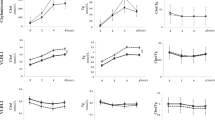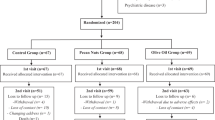Abstract
Background/Objectives:
Diets high in nuts reduce cholesterol, probably due to their favorable lipid profile and other bioactive substances. However, the physical form of the nut may be important as the cell wall of intact nuts may limit the hypocholesterolemic effect of nuts by reducing lipid bioavailability. Therefore, we investigated the effects on blood lipids of incorporating three different forms of hazelnuts (ground, sliced and whole) into the usual diet.
Subjects/Methods:
In a randomized crossover study with three phases, 48 mildly hypercholesterolemic participants were asked to consume 30 g of ground, sliced or whole hazelnuts for 4 weeks. Body weight, plasma total cholesterol (TC), low-density lipoprotein cholesterol (LDL-C), high-density lipoprotein cholesterol (HDL-C), triacylglycerol (TAG), apolipoprotein (apo) A1, apo B100 and α-tocopherol were measured at baseline and at the end of each dietary phase.
Results:
There were no significant differences in any outcome variable between the different forms of nuts (all P⩾0.159). However, compared with baseline, mean values at the end of each hazelnut intervention were significantly higher for HDL-C (P=0.023) and α-tocopherol (P=0.005), and significantly lower for TC (P<0.001), LDL-C (P<0.001), TC:HDL-C ratio (P<0.001), apo B100 (P=0.002) and apo B100:apo A1 ratio (P<0.001), with no significant difference in body weight (P=0.813).
Conclusion
s: The ingestion of three different forms of hazelnuts equally improved the lipoprotein profile and α-tocopherol concentrations in mildly hypercholesterolemic individuals. Hazelnuts can therefore be incorporated into the usual diet as a means of reducing cardiovascular disease risk.
This is a preview of subscription content, access via your institution
Access options
Subscribe to this journal
Receive 12 print issues and online access
$259.00 per year
only $21.58 per issue
Buy this article
- Purchase on Springer Link
- Instant access to full article PDF
Prices may be subject to local taxes which are calculated during checkout
Similar content being viewed by others
References
Albert CM, Gaziano JM, Willett WC, Manson JE (2002). Nut consumption and decreased risk of sudden cardiac death in the Physicians’ Health Study. Arch Intern Med 162, 1382–1387.
Alphan E, Pala M, Ackurt F, Yilmaz T (1997). Nutritional composition of hazelnuts and its effects on glucose and lipid metabolism. Acta Hortic 445, 305–310.
American Institute for Cancer Research and World Cancer Research Fund (1997). Food, Nutrition and the Prevention of Cancer: A Global Perspective. BANTA Book Group: Menasha, WI.
Assmann G, Schriewer H, Schmitz G, Hagele EO (1983). Quantification of high-density-lipoprotein cholesterol by precipitation with phosphotungstic acid/MgCl2. Clin Chem 29, 2026–2030.
Athar N, McLaughlin J, Taylor G, Mishra S (2006). The Concise New Zealand Food Composition Tables 7th edn. New Zealand Institute for Crop and Food Research Limited: Wellington; Ministry of Health: Palmerston North.
Baigent C, Keech A, Kearney PM, Blackwell L, Buck G, Pollicino C et al. (2005). Efficacy and safety of cholesterol-lowering treatment: prospective meta-analysis of data from 90 056 participants in 14 randomised trials of statins. Lancet 366, 1267–1278.
Banel DK, Hu FB (2009). Effects of walnut consumption on blood lipids and other cardiovascular risk factors: a meta-analysis and systematic review. Am J Clin Nutr 90, 56–63.
Berry SEE, Tydeman EA, Lewis HB, Phalora R, Rosborough J, Picout DR et al. (2008). Manipulation of lipid bioaccessibility of almond seeds influences postprandial lipemia in healthy human subjects. Am J Clin Nutr 88, 922–929.
Burton-Freeman B, Davis PA, Schneeman BO (2004). Interaction of fat availability and sex on postprandial satiety and cholecystokinin after mixed-food meals. Am J Clin Nutr 80, 1207–1214.
Cassady BA, Hollis JH, Fulford AD, Considine RV, Mattes RD (2009). Mastication of almonds: effects of lipid bioaccessibility, appetite, and hormone response. Am J Clin Nutr 89, 794–800.
Durak I, Köksal I, Kaçmaz M, Büyükkoçak S, Cimen BMY, Oztürk HS (1999). Hazelnut supplementation enhances plasma antioxidant potential and lowers plasma cholesterol levels. Clin Chim Acta 284, 113–115.
Ellis PR, Kendall CWC, Ren Y, Parker C, Pacy JF, Waldron KW et al. (2004). Role of cell walls in the bioaccessibility of lipids in almond seeds. Am J Clin Nutr 80, 604–613.
Fraser GE, Sabate J, Beeson WL, Strahan TM (1992). A possible protective effect of nut consumption on risk of coronary heart disease. The Adventist Health Study. Arch Intern Med 152, 1416–1424.
Friedewald WT, Levy RI, Fredrickson DS (1972). Estimation of the concentration of low-density lipoprotein cholesterol in plasma, without use of the preparative ultracentrifuge. Clin Chem 18, 499–502.
Frecka JM, Hollis JH, Mattes RD (2008). Effects of appetite, BMI, food form and flavor on mastication: almonds as a test food. Eur J Clin Nutr 62, 1231–1238.
Gebauer SK, West SG, Kay CD, Alaupovic P, Bagshaw D, Kris-Etherton PM (2008). Effects of pistachios on cardiovascular disease risk factors and potential mechanisms of action: a dose-response study. Am J Clin Nutr 88, 651–659.
Gordon DJ, Probstfield JL, Garrison RJ, Neaton JD, Castelli WP, Knoke JD et al. (1989). High-density lipoprotein cholesterol and cardiovascular disease. Four prospective American studies. Circulation 79, 8–15.
Griel AE, Cao Y, Bagshaw DD, Cifelli AM, Holub B, Kris-Etherton PM (2008). A macadamia nut-rich diet reduces total and LDL-cholesterol in mildly hypercholesterolemic men and women. J Nutr 138, 761–767.
Hollis J, Mattes R (2007). Effect of chronic consumption of almonds on body weight in healthy humans. Br J Nutr 98, 651–656.
Hu FB, Willett WC (2002). Optimal diets for prevention of coronary heart disease. JAMA 288, 2569–2578.
Jambazian PR, Haddad E, Rajaram S, Tanzman J, Sabaté J (2005). Almonds in the diet simultaneously improve plasma [alpha]-tocopherol concentrations and reduce plasma lipids. J Am Diet Assoc 105, 449–454.
King JC, Blumberg J, Ingwersen L, Jenab M, Tucker KL (2008). Tree nuts and peanuts as components of a healthy diet. J Nutr 138 (Suppl), S1736–S1740.
Krauss RM, Eckel RH, Howard B, Appel LJ, Daniels SR, Deckelbaum RJ et al. (2000). AHA dietary guidelines: revision 2000: a statement for healthcare professionals from the nutrition committee of the American Heart Association. Stroke 31, 2751–2766.
Kris-Etherton PM, Pearson TA, Wan Y, Hargrove RL, Moriarty K, Fishell V et al. (1999a). High-monounsaturated fatty acid diets lower both plasma cholesterol and triacylglycerol concentrations. Am J Clin Nutr 70, 1009–1015.
Kris-Etherton PM, Yu-Poth S, Sabate J, Ratcliffe HE, Zhao G, Etherton TD (1999b). Nuts and their bioactive constituents: effects on serum lipids and other factors that affect disease risk. Am J Clin Nutr 70 (Suppl), S504–S511.
Kushi LH, Folsom AR, Prineas RJ, Mink PJ, Wu Y, Bostick RM (1996). Dietary antioxidant vitamins and death from coronary heart disease in postmenopausal women. N Engl J Med 334, 1156–1162.
Law MR, Wald NJ (2002). Risk factor thresholds: their existence under scrutiny. BMJ 324, 1570–1576.
Mandalari G, Faulks RM, Rich GT, Lo Turco V, Picout DR, Lo Curto RB et al. (2008). Release of protein, lipid, and vitamin E from almond seeds during digestion. J Agric Food Chem 56, 3409–3416.
Marshall R (2003). Diet Entry and Storage, Diet Cruncher: A Batch Processing Diet Analysis System for the PC Nutricomp: Dunedin.
Mercanligil SM, Arslan P, Alasalvar C, Okut E, Akgul E, Pinar A et al. (2007). Effects of hazelnut-enriched diet on plasma cholesterol and lipoprotein profiles in hypercholesterolemic adult men. Eur J Clin Nutr 61, 212–220.
New Zealand Guidelines Group (2003). Evidence-based Best Practice Guideline: The Assessment and Management of Cardiovascular Risk. New Zealand Guidelines Group: Wellington.
New Zealand Institute for Crop and Food Research (2006). FOODfiles. Datafiles of the New Zealand Food Composition Database. New Zealand Institute for Crop and Food Research: Palmerston North.
Phung OJ, Makanji SS, White CM, Coleman CI (2009). Almonds have a neutral effect on serum lipid profiles: a meta-analysis of randomized trials. J Am Diet Assoc 109, 865–873.
Rajaram S, Burke K, Connell B, Myint T, Sabate J (2001). A monounsaturated fatty acid-rich pecan-enriched diet favorably alters the serum lipid profile of healthy men and women. J Nutr 131, 2275–2279.
Sabate J, Haddad E, Tanzman JS, Jambazian P, Rajaram S (2003). Serum lipid response to the graduated enrichment of a step I diet with almonds: a randomized feeding trial. Am J Clin Nutr 77, 1379–1384.
Sathe SK, Monaghan EK, Kshirsagar HH, Venkatachalam M (2009). Chemical composition of edible nut seeds and its implications in human health. In: Alasalvar C, Shahidi F (eds). Tree Nuts: Composition, Phytochemicals, and Health Effects. Taylor & Francis Group: Florida. pp 12–36.
Segura R, Javierre C, Lizarraga MA, Ros E (2006). Other relevant components of nuts: phytosterols, folate and minerals. Br J Nutr 96 (Suppl 2), S36–S44.
Thurnham DI, Smith E, Flora PS (1988). Concurrent liquid-chromatographic assay of retinol, alpha-tocopherol, beta-carotene, alpha-carotene, lycopene, and beta-cryptoxanthin in plasma, with tocopherol acetate as internal standard. Clin Chem 34, 377–381.
Torabian S, Haddad E, Cordero-MacIntyre Z, Tanzman J, Fernandez ML, Sabate J (2010). Long-term walnut supplementation without dietary advice induces favorable serum lipid changes in free-living individuals. Eur J Clin Nutr 64, 274–279.
Traoret CJ, Lokko P, Cruz ACRF, Oliveira CG, Costa NMB, Bressan J et al. (2008). Peanut digestion and energy balance. Int J Obes 32, 322–328.
Acknowledgements
We thank the participants for their commitment and enthusiasm in participating in this study. We thank Miss Michelle Harper and Mr Ashley Duncan for technical assistance in analyzing the blood samples. We also thank Mrs Margaret Waldron and Mrs Sue Vorgers for expert venipuncture and support of participants. This work was funded and supported by the National Heart Foundation of New Zealand Grant number 1234.
Author information
Authors and Affiliations
Corresponding author
Ethics declarations
Competing interests
The authors declare no conflict of interest.
Rights and permissions
About this article
Cite this article
Tey, S., Brown, R., Chisholm, A. et al. Effects of different forms of hazelnuts on blood lipids and α-tocopherol concentrations in mildly hypercholesterolemic individuals. Eur J Clin Nutr 65, 117–124 (2011). https://doi.org/10.1038/ejcn.2010.200
Received:
Revised:
Accepted:
Published:
Issue Date:
DOI: https://doi.org/10.1038/ejcn.2010.200
Keywords
This article is cited by
-
Manufacturing plant-based non-dairy and probiotic frozen desserts and their impact on physicochemical, sensory and functional aspects
Journal of Food Science and Technology (2024)
-
Can Improving the Nutritional Content of Bread Enhance Cognition? Cognitive Outcomes from a Randomized Controlled Trial
Journal of Cognitive Enhancement (2020)
-
Biomarkers of food intake for nuts and vegetable oils: an extensive literature search
Genes & Nutrition (2019)
-
Energy compensation and nutrient displacement following regular consumption of hazelnuts and other energy-dense snack foods in non-obese individuals
European Journal of Nutrition (2017)
-
Do dry roasting, lightly salting nuts affect their cardioprotective properties and acceptability?
European Journal of Nutrition (2017)



